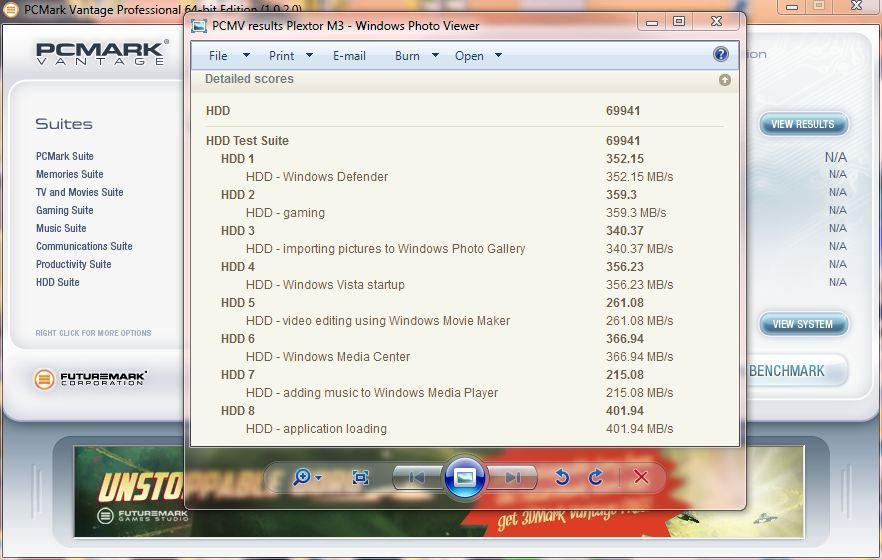PCMARK VANTAGE X64 HDD SUITE
The SSD Review uses benchmark software called PCMark Vantage x64 HDD Suite to create testing scenarios that might be used in the typical user experience. There are eight tests in all and the tests performed record the speed of data movement in MB/s to which they are then given a numerical score after all of the tests are complete. The simulations are as follows:
- Windows Defender In Use
- Streaming Data from storage in games such as Alan Wake which allows for massive worlds and riveting non-stop action
- Importing digital photos into Windows Photo Gallery
- Starting the Vista Operating System
- Home Video editing with Movie Maker which can be very time consuming
- Media Center which can handle video recording, time shifting and streaming from Windows media center to an extender such as XBox
- Cataloging a music library
- Starting applications
PLEXTOR M3 SATA 3 PCMARK VANTAGE RESULTS
The Plextor M3 gives us a very good showing with an overall score of 69941, capped with a 401.94 score in the HDD application loading test. This shows that the drive is very well tuned to the typical desktop user data access patterns. Part of this is going to be due to the very low access times that we have seen over the course of testing with many of the benchmarks. Low access times equal great overall response time and snappiness that can be observed by the end user in everyday tasks.
 The following chart comprises the entirety of new Gen SATA 3 SSDs that we have testing and the placement was dependent strictly on the result attained in PCMark Vantage HDD Test Suite.
The following chart comprises the entirety of new Gen SATA 3 SSDs that we have testing and the placement was dependent strictly on the result attained in PCMark Vantage HDD Test Suite.  The Plextor M3 placed in the top five of all ‘new gen’ SATA 3 SSDs that we have reviewed which says alot for both the drive and Marvell controller.
The Plextor M3 placed in the top five of all ‘new gen’ SATA 3 SSDs that we have reviewed which says alot for both the drive and Marvell controller.
 The SSD Review The Worlds Dedicated SSD Education and Review Resource |
The SSD Review The Worlds Dedicated SSD Education and Review Resource | 
How does the M3 compare to the M2?
The M2 is 480/330 read/write and 15K/9K IOPS. The M3 is 510/360 read/write and 70K/65K IOPS. Also, the M2 comes bundled with the Acronis software where as the M3 is bundled with NTI Echo. Both drives have the same Marvell controller. However the M3 uses a Toshiba 24nm NAND as opposed to a Toshiba 32nm NAND found in the M2.
whats the different between Plextor M3 and M3P ?
The M3P is essentially the M3S but with a different firmware which increases performance from 525/445 read/write to 535/450 and from 56K/30K IOPS to 56K/34K IOPS on the 512GB. Also, I believe the M3P is housed in a 7mm casing as opposed to a 9.5mm casing.
If Marvell = faster latency but also lower bandwidth, does that mean if I’m RAID-0’ing 2 SSDs (for higher bandwidth speeds), I’d be better off with a Marvell controlled pair of SSDs rather than a pair of SandForce controlled ones?
Not sure how to answer this question but you can check out the M2 RAID benchmark results https://www.plextoramericas.com/index.php/forum/27-ssd/4716-128-gb-m2p-benchmarks?limit=6&start=18#4734